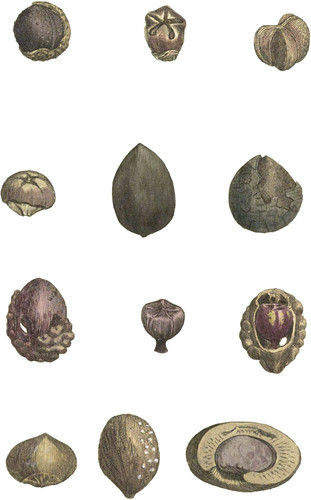 Enlarge
Enlarge
British Mineralogy
Sulphuret of Iron, or Iron Pyrites
- Div. 2. Imitative.
Among other geological formations, perhaps, that are least noticed in works of this kind up to the present time, are those of fruits that are preserved in a Carbonaceous Pyrites, if I may so term the substance in which the Carbon, or remains of the Wood, is more or less incorporated with the Pyrites which has chiefly taken place of the Wood, like some parts of the left hand upper fig. &c.
The present specimens are from the cliffs of Sheppy Island, near Minster (whence the Sulphate of Barytes, commonly called Lepastrum—see tabs. 172, 173*).
Many of these fruits fall to pieces from a certain excess of moisture which acts occasionally on this combination, by which many valuable specimens are lost from time to time. I was therefore glad to figure some while in a proper state.
The upper left hand figure represents a nearly round, semi-spined fruit with a flattish sulcus on one side. It is enclosed in a shell which is partly indented inwardly, opposite the spines. It is thick and irregular on the outside, and does not agree with any fruit now known.
The upper middle figure is a five-valved capsule.
The upper right hand figure is not much unlike the capsule of Thea viridis, but is less regular: nor does it agree with any Euphorbia so well as with Menispermum, Gærtn. t. 70.
In the second row the left hand figure is very different from any thing I know at present; as it appears to have had a fleshy capsule below a calyx of five divisions, and has within it a thinner woody capsule splitting in to five divisions.
The middle figure was not unlike some gourd seeds, but is now lost by decomposition.
The right hand one represents a flattish woody capsule, probably having had a fleshy outside.
The third row consists of three figures of a capsule somewhat resembling a hazel nut, partly covered with bubbled Pyrites. The left hand figure shows the outside; the right hand one represents the shell broken, as found, with a regular pentagonal seed within, which is shown more distinctly in the middle figure: this is occasionally found separate from the other part.
The lower line has in the left hand figure a seed or fruit similar to a nut, but the base has particular marks that do not agree with it.
The middle figure resembles the longish nutmeg, with the mace enveloping one side. On one part are protuberances which have a white Lime or Chalk upon them.
The right hand figure is a little like a half of a Kentish cherry with the stone; the outer part or mass is metallic Pyrites, formed as it were round the stone as from a centre, showing the peculiar construction of the fleshy part of a cherry.
Some of the specimens figured are in my own cabinet; with the others I have been favoured by Mr. Francis Crow of Feversham, who has a large and curious collection, of which I shall have an opportunity of saying more hereafter.
- * I said, when those figures were done, that they were not found anywhere else; but I have since gathered them from the opposite cliffs at Southend, and have found small specimens at Sydenham in the Croydon canal.

